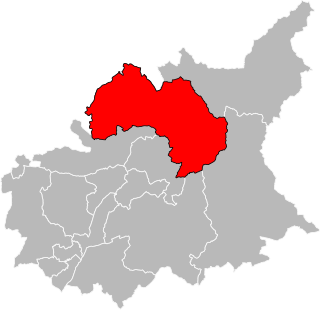
Gap is the prefecture of the department of Hautes-Alpes, in the region of Provence-Alpes-Côte d'Azur, Southeastern France. In 2019, the commune had a population of 40,631, making it the most populated city in Hautes-Alpes. At a height of 750 metres above sea level, to the south of the Écrins Massif, it is also France's highest prefecture.

Sisteron is a commune in the Alpes-de-Haute-Provence department, Provence-Alpes-Côte d'Azur, southeastern France.

Banon is a commune in the department of Alpes-de-Haute-Provence in the Provence-Alpes-Côte d'Azur region of south-eastern France.

The arrondissement of Forcalquier is an arrondissement of France in the Alpes-de-Haute-Provence department in the Provence-Alpes-Côte d'Azur region. It has 97 communes. Its population is 95,990 (2016), and its area is 2,605.4 km2 (1,006.0 sq mi).

Authon is a commune in the Alpes-de-Haute-Provence department in the Provence-Alpes-Côte d'Azur region of south-eastern France.

Aubenas-les-Alpes is a commune in the Alpes-de-Haute-Provence department in the Provence-Alpes-Côte d'Azur region of south-eastern France.

Aubignosc is a commune in the Alpes-de-Haute-Provence department in the Provence-Alpes-Côte d'Azur region of south-eastern France.

Auzet is a commune in the Alpes-de-Haute-Provence department in the Provence-Alpes-Côte d'Azur region of south-eastern France.

Barles is a commune in the Alpes-de-Haute-Provence department in the Provence-Alpes-Côte d'Azur region of south-eastern France.

Bayons is a commune in the Alpes-de-Haute-Provence department in the Provence-Alpes-Côte d'Azur region of south-eastern France.

Ganagobie is a commune in the Alpes-de-Haute-Provence department in southeastern France.

Prads-Haute-Bléone is a commune in the Alpes-de-Haute-Provence department and in the Provence-Alpes-Côte d'Azur region in southeastern France.

Seyne is a commune in Alpes-de-Haute-Provence, a department of the Provence-Alpes-Côte d'Azur region in south-east France. It is roughly 30 km north of Digne.

Sigonce is a commune in the Alpes-de-Haute-Provence department in southeastern France.

Le Vernet is a commune in the Alpes-de-Haute-Provence department, and in the region of Provence-Alpes-Côte d'Azur, in southeastern France.

The canton of Seyne is an administrative division in southeastern France. At the French canton reorganisation which came into effect in March 2015, the canton was expanded from 8 to 34 communes:
The canton of Turriers is a former administrative division in southeastern France. It was disbanded following the French canton reorganisation which came into effect in March 2015. It consisted of 7 communes, which joined the canton of Seyne in 2015. It had 1,265 inhabitants (2012).

Alpes-de-Haute-Provence or sometimes abbreviated as AHP, formerly until 1970 known as Bas-Alpes, is a department in the Provence-Alpes-Côte d'Azur region of France, bordering Alpes-Maritimes and Italy to the east, Var to the south, Vaucluse to the west, Drôme and Hautes-Alpes to the north. Formerly part of the province of Provence, it had a population of 164,308 in 2019, which makes it the 8th least populated department and the 94th most populated French department.

The Communauté d'agglomération Provence-Alpes or Provence-Alpes Agglomération is a French agglomeration community, created on 21 October 2016, located in the department of Alpes-de-Haute-Provence, in region Provence-Alpes-Côte d'Azur. Its seat is Digne-les-Bains. Its area is 1574.0 km2. Its population was 47,382 in 2018, which is 29% of the population of Alpes-de-Haute-Provence.

The Digne Prealps are a massif in the southern part of the French Prealps located in the department of Alpes-de-Haute-Provence.























